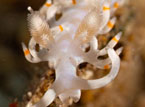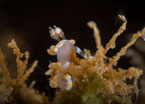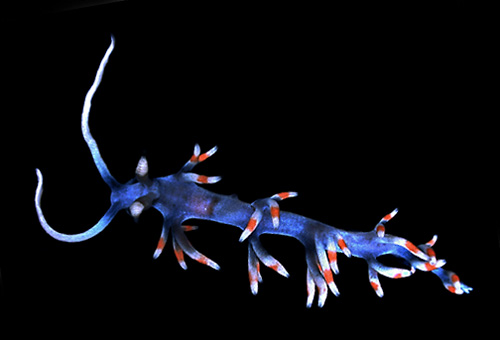| Home |
| Acknowledgments |
| Conventions |
| Glossary |
| Maps |
| References |
| Links |
| Articles |
| Thumbnails |
| Species
list |
| Family |
| Next
species |
Additional Photos

underside

rhinophores

white spotted

feeding?

mating

with egg mass
_______________
GALLERY

Samla bicolor (Kelaart, 1858)

| Maximum Size: 20 mm. Identification: This aeolid is translucent bluish-white with opaque white on the cephalic tentacles, rhinophores and cerata. Animals from deeper water often have irregular, opaque-white patches on the notum. The cerata have partial or complete bright orange subapical bands. The oral tentacles can appear relatively short and cylindrical or extremely long and laterally compressed depending on posture. They may be white along most of their length or have a translucent medial band. Natural History: Samla bicolor is a common diurnal species found in moderately protected to exposed rocky habitats and in Halimeda kanaloana beds from the low intertidal to at least 24 m (79 ft). A 7.5 mm animal of the deep water color form laid a spiral egg mass of 1.3 whorls that was 1.5 mm in diameter with a 0.4 mm high ribbon. It was pale pinkish-orange in color. Distribution: Big Island, Maui, Oahu, Niihau, Laysan, Midway and Kure: widely distributed in the Indo-Pacific. Taxonomic notes: This is the species listed as Flabellina sp. in Kay, 1979 and as Flabellina alisonae in Bertsch & Johnson, 1981 as well as Gosliner, 1980. In addition, Flabellina annuligera Bergh, 1900, described from Laysan and listed separately in Kay (1979) is considered a synonym. (Gosliner & Willan, 1991) There is some possibility that the white spotted and translucent animals might ultimately turn out to be different species. (Note 1) Gosliner, et. al. (2018) illustrates the spotted form as "Samla sp. #4." It's referred to as the "bicolor nudibranch" in Hoover, 1998 & 2006 where it's listed as Flabellina bicolor (corrected in 2019 printing). It was first reported from Hawaii in Bergh, 1900. Some other sources also use Flabellina bicolor. Photo: PF: off Makena, Maui; October, 1989. Observations and comments: Note 1: In our experience, translucent animals are found over a fairly broad depth range starting at < 1 m (< 3 ft). In contrast, white spotted animals appear to be less common and confined to depths over 10 m (33 ft). |
| Thumbnails |
Species
list |
Family | Next species | Top |